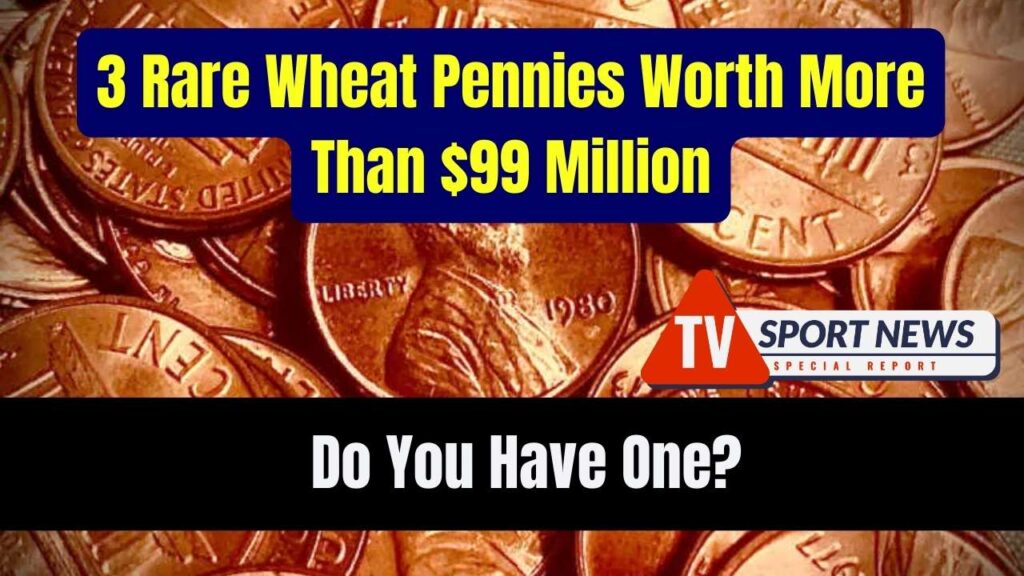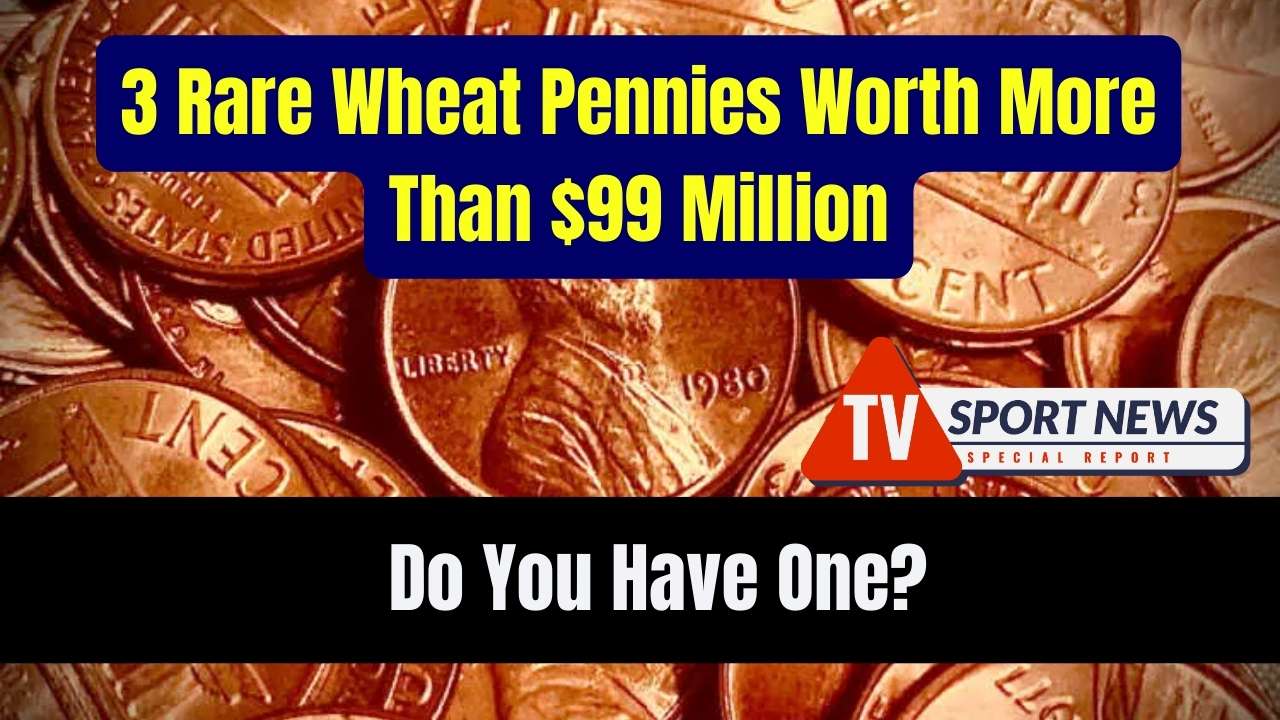3 Rare Wheat Pennies Worth More Than $99 Million – If you’ve ever held onto a jar of old coins or inherited a dusty box from your grandparents, you may be sitting on a gold mine without even knowing it. Rare wheat pennies, small copper coins minted between 1909 and 1958, have become the stuff of legend among coin collectors. Some are so valuable that they’re worth more than a luxury home — or even a private island.

In this article, we’ll explore the top 3 rare wheat pennies worth more than $99 million combined, explain what makes them so special, and give you practical tips on how to check if you might own one. Whether you’re a coin enthusiast, a casual collector, or just someone curious about old money, this guide will make it easy (and fun!) to understand why these coins are so valuable.
3 Rare Wheat Pennies Worth More Than $99 Million
| Feature | Details |
|---|---|
| Top 3 Valuable Wheat Pennies | 1943-D Bronze Penny, 1944-S Steel Penny, 1909-S VDB Penny |
| Most Expensive Known Sale | $1.7 million (1943-D Bronze, private auction) |
| Total Estimated Combined Value | Over $99 million (based on rarity and demand) |
| Years to Watch For | 1909, 1943, 1944 |
| Where to Check Your Pennies | Look under the year and mint mark on the front; refer to PCGS Official Website for grading help |
| Authentication Services | NGC, Heritage Auctions, PCGS |
Finding one of these rare wheat pennies might seem like winning the lottery — and in some ways, it is. Whether it’s the 1943-D Bronze Penny, the 1944-S Steel Penny, or the classic 1909-S VDB, these coins are a testament to history, human error, and collector passion. If you’ve got a coin jar sitting around, now might be the perfect time to take a closer look.
What Are Wheat Pennies?
Wheat pennies, also called Lincoln Wheat Cents, were produced by the U.S. Mint from 1909 to 1958. They are instantly recognizable by the two wheat stalks on the reverse side, which frame the words “One Cent.”
These coins replaced the Indian Head penny and were the first U.S. coins to feature a real person: President Abraham Lincoln. That alone makes them historically significant, but certain rare varieties are also incredibly valuable due to minting errors, low production runs, or unique metal compositions.
Wheat pennies come in three main types:
- Early wheat pennies (1909–1939), often with lower mintages
- Wartime pennies (1941–1945), made with alternative metals
- Post-war wheat pennies (1946–1958), more common in circulation
1. The 1943-D Bronze Wheat Penny — The $1.7 Million Coin
In 1943, the U.S. Mint used zinc-coated steel instead of copper for pennies to save metal for World War II. But a few copper blanks (called planchets) were left in the machines and accidentally stamped with the 1943 date.
One of these mistakes happened at the Denver Mint, producing the ultra-rare 1943-D Bronze Wheat Penny.
Why It’s So Valuable:
- Only one known authentic copy has been found
- Sold for $1.7 million in a private sale
- It is considered one of the Holy Grails of coin collecting
How to Spot One:
- Look for the date 1943 on the front (obverse)
- It should not be magnetic (steel ones are; bronze is not)
- Check for the small “D” mintmark under the date
If you think you have one, get it professionally authenticated!
2. The 1944-S Steel Wheat Penny – A Million-Dollar Error
In 1944, the U.S. Mint returned to using copper for pennies. However, a few steel blanks left over from 1943 were accidentally used, creating a few 1944 steel pennies.
The rarest among them is the 1944-S Steel Penny, minted in San Francisco.
Why It’s So Valuable:
- Only a handful of these coins exist
- One example sold for $1.1 million
- It’s a dramatic error that shouldn’t exist
How to Spot One:
- Look for the date 1944 and a small “S” under the year
- Steel coins are magnetic, unlike copper
- It should look silver, not brown or reddish
3. The 1909-S VDB Wheat Penny – The Collector’s Favorite
This coin is famous for both its rarity and the controversy around it. The initials “VDB” on the reverse side stand for Victor David Brenner, the coin’s designer. The public backlash over the prominent initials led the Mint to halt production quickly.
Only 484,000 coins were minted with the “S” (San Francisco) mintmark before being pulled from circulation.
Why It’s So Valuable:
- First year of Lincoln cent production
- Controversial initials and limited production
- High collector demand
How to Spot One:
- Look for the 1909 date
- Check for “S” under the date
- Flip the coin and look for “V.D.B.” near the bottom edge of the reverse side
One high-grade example sold for over $360,000.
Bonus Tip: Other Wheat Pennies Worth Noticing
While these top 3 make headlines, here are a few others you should watch for:
- 1914-D: Low mintage, can sell for over $5,000 in good condition
- 1922 No D: Denver Mint error where the “D” mintmark is missing
- 1955 Doubled Die: Obvious double lettering on the date and inscriptions
These coins aren’t worth millions, but they still bring in thousands at auctions.
Why Are These Coins Worth So Much?
There are three main factors that drive up a wheat penny’s value:
1. Rarity
The fewer coins that exist, the higher the demand among collectors.
2. Mint Errors
Coins accidentally made with the wrong metal or design fetch enormous prices.
3. Condition (Grading)
Coins in better condition (with no scratches or fading) are worth more. The Professional Coin Grading Service (PCGS) can grade your coins from 1 to 70. Learn more at pcgs.com.
How to Check If You Own a Rare Wheat Penny?
Step-by-Step Guide:
- Gather your coins: Look through old jars, drawers, or coin albums
- Check the dates: Focus on coins from 1909, 1943, and 1944
- Look for mint marks: Small letters under the year: D = Denver, S = San Francisco
- Test with a magnet: A quick way to check for steel vs. copper
- Use a magnifying glass: To spot small details like “V.D.B.”
- Compare online: Use images from PCGS or NGC
- Get a professional opinion: Have your coin graded if you suspect it’s rare
Average $1,580 Direct Deposits and Checks for SSDI in April 2025: Check Eligibility Criteria!
$2,400 Federal Benefit Confirmed for 2025 – Find Out If You’re Eligible Now!
FAQs
How much is a 1943 steel penny worth?
Most are worth only 10 to 50 cents, but if it’s mistakenly made in bronze, it can be worth hundreds of thousands or more.
Can wheat pennies still be found in circulation?
Rarely, but yes! Some still appear in rolls of coins from banks or estate sales.
What is the best way to sell a rare coin?
Use trusted dealers or auction houses like Heritage Auctions or platforms like eBay, but always get your coin graded first.
Are all wheat pennies valuable?
Not all. Most are worth between 2 to 15 cents, but key dates or mint errors can make them extremely valuable.
Where can I learn more about coin collecting?
You can start with high-authority resources like:
- PCGS Coin Facts
- NGC Price Guide
- U.S. Mint Education










